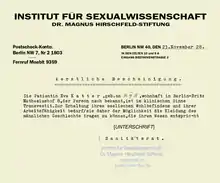Transvestite certificate
A transvestite certificate was a doctor's note issued by the governments of Imperial Germany and the Weimar Republic – under the support of sexologist Magnus Hirschfeld – identifying a person as a transvestite. Transvestite at this time referred to all individuals whose gender identity and preferred clothing was discordant to that associated with their assigned sex, and so included both crossdressing and transgender people.[3]
.jpg.webp)
Between 1908 and up until the 1950s, "perhaps dozens" of such passes were granted by the German police.[4] Mainly given to middle-class, heterosexual, male-to-female transvestites to avoid associations with gay and lesbian culture in Weimar Germany. The certificate said that the individual in question was allowed to wear clothing which corresponded to their gender identity.[3]
See also
- Transgender rights in Germany (since 1980)
References
- Jander, Thomas (23 July 2019). "What's that for? A Licence to Be (Different) – Deutsches Historisches Museum: Blog". Retrieved 5 February 2021.
- Taylor, Michael T.; Timm, Annette; Herrn, Rainer (30 October 2017). Not Straight from Germany: Sexual Publics and Sexual Citizenship Since Magnus Hirschfeld. University of Michigan Press. p. 44. ISBN 978-0-472-13035-1. Retrieved 5 February 2021.
- Gershon, Livia (18 November 2018). "Gender Identity in Weimar Germany". JSTOR Daily. Retrieved 19 July 2019.
- Frost, Natasha (2 November 2017). "The Early 20th-Century ID Cards That Kept Trans People Safe From Harassment". Atlas Obscura. Retrieved 19 July 2019.
